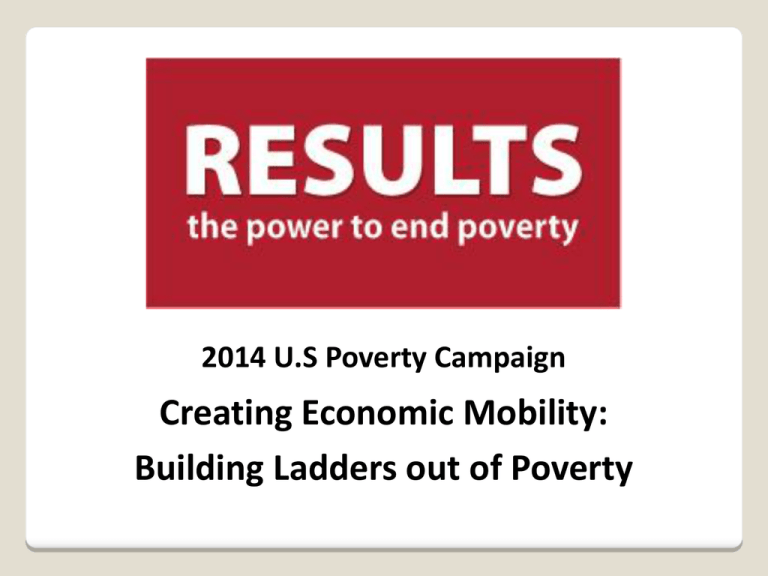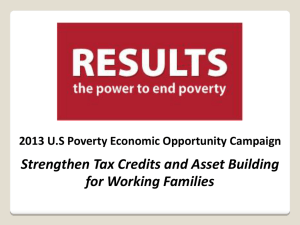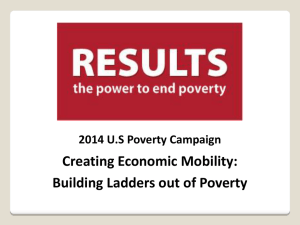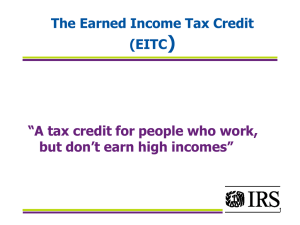PowerPoint
advertisement

2014 U.S Poverty Campaign Creating Economic Mobility: Building Ladders out of Poverty 2014 U.S. Poverty Campaigns Main Campaign: Creating Economic Mobility: Building Ladders out of Poverty Protect and expand the Earned Income Tax Credit and Child Tax Credit Support Asset Building strategies like the Financial Security Credit Targeted Campaign: Early Childhood Development Protect Child Nutrition programs Protect Investments in Head Start and Child Care 2 3 2014 Economic Mobility Campaign 2014 EITC/CTC Request • Ask members of Congress to speak to tax leaders, urging them to: o o o Strengthen progressivity in the tax code Make the 2009 EITC and CTC improvements permanent, Expand the EITC for childless workers. These components should be key in any discussions of comprehensive tax reform • Urge your members of Congress to cosponsor S.836, H.R.2116, and H.R.769 4 2014 Economic Mobility Campaign Key Members Senate: • Senate Finance Committee Chair Ron Wyden (DOR) • Ranking Member Orrin Hatch (R-Utah) House: • Ways and Means Committee Chair Dave Camp (RMI-4) • Ranking Member Sander Levin (D-MI-9) 5 2014 Economic Mobility Campaign EITC/CTC Legislation • S.836 – Working Families Tax Relief Act of 2013 - Senator Sherrod Brown (D-OH) o Makes 2009 improvements to EITC and CTC permanent o Expands the EITC for childless workers • H.R.2116 – Earned Income Tax Credit Improvement and Simplification Act of 2013 – Rep. Richard Neal (D-MA-1) o Makes 2009 improvements to EITC permanent o Expands EITC for childless workers • H.R.769 – Child Tax Credit Permanency Act of 2013 – Rep. Rosa DeLauro (D-CT-3) o Makes 2009 improvements to CTC permanent 6 2014 Economic Mobility Campaign Targets to Cosponsor S.836 • • • • • • Maria Cantwell (D-WA) Thomas Carper (D-DE) Dianne Feinstein (D-CA) Kay Hagan (D-NC) Martin Heinrich (D-NM) Barbara Mikulski (D-MD) • • • • • Bill Nelson (D-FL) Mark Pryor (D-AR) John Walsh (D-MT) Mark Udall (D-CO) Tom Udall (D-NM) 7 2014 Economic Mobility Campaign EITC and CTC Laser Talk Engage: The Earned Income Tax Credit (EITC) and Child Tax Credit (CTC) lifted 10.1 million people, including 5.3 million children, out of poverty in 2012 – more than any other program except for Social Security. 8 2014 Economic Mobility Campaign EITC and CTC Laser Talk Engage: How many Americans did the Earned Income Tax Credit (EITC) and Child Tax Credit (CTC) lift out of poverty? How many kids? What’s the only program to lift more Americans out of poverty? 9 2014 Economic Mobility Campaign EITC and CTC Laser Talk Problem: 12 million people, including 7 million children, could fall into poverty or deeper into poverty when important improvements to these credits expire in 2017. And the EITC could do more to support low-income single adults. 10 2014 Economic Mobility Campaign EITC and CTC Laser Talk Problem: How many Americans could fall into poverty or deeper into poverty when EITC/CTC improvements expire in 2017? In your state? How many kids? In your state? What population do we need to reach better with the EITC? 11 2014 Economic Mobility Campaign EITC and CTC Laser Talk Inform: Some in Congress are pushing forward legislation to give over $500 billion in tax breaks to corporations – while doing nothing to protect and strengthen these critical anti-poverty tax credits. The EITC has been shown to encourage work, improve infant health, lead to children doing better at school, and then those children are more likely to earn more as adults. Let’s not cut supports that help working families and make such a difference and instead support bipartisan efforts to expand tax credits to “childless” workers. 12 2014 Economic Mobility Campaign EITC and CTC Laser Talk Inform: Some in Congress are pushing forward legislation that gives over how much in tax breaks to corporations? Do these bills protect and strengthen these critical antipoverty tax credits? What are some of the benefits of the EITC? • What story can you tell to make this real? There is bipartisan support for expanding tax credits to what population? (Bonus: who is talking about this?) 13 2014 Economic Mobility Campaign EITC and CTC Laser Talk Senate Call to Action: Will you speak and/or write directly to Senate Finance Committee Chairman Ron Wyden and ranking Member Orrin Hatch, urging them to help working Americans meet their basic needs by protecting and strengthening tax credits for low-income Americans, specifically by making expiring EITC and CTC provisions permanent and expanding the EITC for childless workers? In addition, will you show your support for working families by co-sponsoring S. 836 (the Working Families Tax Relief Act of 2013)? 14 2014 Economic Mobility Campaign EITC and CTC Laser Talk Senate Call to Action: Who are the key leaders who write tax policy? What do you want your senator to do? What policy changes should they support? In addition, which legislation can senators cosponsor to show their support for EITC and CTC? 15 2014 Economic Mobility Campaign EITC and CTC Laser Talk House Call to Action: Will you speak and/or write directly to House Ways and Means Committee Chairman Dave Camp (R-MI) and Sander Levin (D-MI) , urging them to help working Americans meet their basic needs by protecting and strengthening tax credits for low-income Americans, specifically by making expiring EITC and CTC provisions permanent and expanding the EITC for childless workers? In addition, will you show your support for working families by co-sponsoring H.R. 769 (Child Tax Credit Permanency Act) and H.R. 2116 (the Earned Income Tax Credit Improvement and Simplification Act)? 16 2014 Economic Mobility Campaign EITC and CTC Laser Talk House Call to Action: Who are the key leaders who write tax policy? What do you want your representative to do? What policy changes should they support? In addition, which legislation can representatives cosponsor to show their support for EITC? Which legislation can representatives cosponsor to show their support for CTC? 17 2014 Economic Mobility Campaign 2013 Assets Request House and Senate: Urge tax leaders to expand policies that help low-income Americans build savings and assets. In particular, urge them to include the Financial Security Credit in any new tax legislation. Also urge House members to cosponsor H.R. 2917. Senate targets: • Senate Finance Committee Chairman, Ron Wyden (D-OR) • Ranking Member, Orrin Hatch (R-UT) House targets: • Ways and Means Committee Chairman, Dave Camp (R-MI-4) • Ranking Member, Sander Levin (D-MI-9) 18 2014 Economic Mobility Campaign Asset-Building Legislation • H.R. 2917 – Financial Security Credit Act of 2013 – Rep. Jose Serrano (D-NY) • Low-income tax filers would receive a 50% match, up to $500, for depositing all or part of tax refund into eligible savings product and retaining their initial deposit amount for at least 8 months • No Senate bill yet 19 2014 Economic Mobility Campaign Assets/FSC Laser Talk Engage: We know that savings are important for helping families deal with financial emergencies and build for the future. Studies show that 71 percent of low-income children born into families that save move up the income ladder as adults. 20 2014 Economic Mobility Campaign Assets/FSC Laser Talk Engage: Why are savings important? What percentage of low-income children born into families that save move up the income ladder as adults? 21 2014 Economic Mobility Campaign Assets/FSC Laser Talk Problem: 44 percent of American households are considered “liquid asset poor”, meaning they don’t have enough savings to live at the poverty level for three months – and the Great Recession showed that many Americans faced struggles when someone in the family lost a job. 22 2014 Economic Mobility Campaign Assets/FSC Laser Talk Problem: What percentage of American households are considered “liquid asset poor”? What does that mean? What has happened the past few years that shows why savings are important? 23 2014 Economic Mobility Campaign Assets/FSC Laser Talk Inform/Illustrate: Our tax code provides hundreds of billions per year in tax incentives to encourage building savings and assets -- yet of the more than $400 billion in tax incentives that promote asset-building, less than three percent benefit the bottom 40 percent of earners (those making about $75,000 per year or less). Tax policy should help more Americans create wealth, not simply reward those who already have it. The Financial Security Credit can help correct this imbalance by allowing low-income tax filers to deposit part of their tax refund into a savings account right on their tax return and get support to build savings. A similar pilot program called SaveUSA has shown that this kind of program really does help people to save. 24 2014 Economic Mobility Campaign Assets/FSC Laser Talk Inform/Illustrate: Approximately how much is spent per year in tax incentives to encourage building savings and assets? •In your own life, why has savings made a difference? What percentage benefits the bottom 40 percent of earners (those making about $75,000 per year or less)? What is a policy idea (which RESULTS supports) can help lowincome tax filers build savings? How does it work? Which pilot program has shown this kind of program works? 25 2014 Economic Mobility Campaign Assets/FSC Laser Talk Senate Call to Action: Will you speak and/or write directly to Senator Finance Committee Chairman Ron Wyden and ranking Member Orrin Hatch, urging them to prioritize policies that help low-income families save? In particular, will you talk to them about the Financial Security Credit and urge them to include it in any tax reform legislation? 26 2014 Economic Mobility Campaign Assets/FSC Laser Talk Senate Call to Action: Who are the key leaders who write tax policy? What do you want your senator to do? What policy changes should they support? 27 2014 Economic Mobility Campaign Assets/FSC Laser Talk House Call to Action: Will you speak and/or write directly to House Ways and Means Committee Chairman Dave Camp (R-MI) and Sander Levin (D-MI) urging them to prioritize policies that help low-income families save? In particular, will you talk to them about the Financial Security Credit and urge them to include it in any tax reform legislation, and cosponsor H.R.2917 (the Financial Security Credit Act)? 28 2014 Economic Mobility Campaign Assets/FSC Laser Talk House Call to Action: Who are the key leaders who write tax policy? What do you want your representative to do? What policy changes should they support? In addition, which legislation can representatives cosponsor to show their support for the Financial Security Credit? 29 2014 Economic Mobility Campaign Economic Mobility: Anticipated Questions Tip: don’t start on defense, but good to be prepared Tip: remember your ABCs A = Acknowledge B = Bridge C = Core Message 30 2014 Economic Mobility Campaign Economic Mobility: EITC Fraud? EITC error rate = about 25 percent •includes simple errors, overpayments, and underpayments. •Probably overestimated, 40 percent successfully appealed. •2008 data; the IRS has taken steps to improvement the error rate since 2009. Paid preparers •62 percent of EITC recipients use a paid •Better regulate paid preparers (but federal court ruled that the IRS did not have this authority) •Congress has the power to provide the IRS better tools •Invest more in volunteer tax preparation (VITA) programs 31 2014 Economic Mobility Campaign Economic Mobility: Poverty Trap? EITC promotes work, particular for single mothers. EITC and the CTC lifted 10.1 million out of poverty in 2012. EITC was the single biggest factor in boosting employment among single mothers 32 33 2014 Economic Mobility Campaign Economic Mobility: What’s the Cost? (1/2) Start with positive message/context… EITC helps hardworking families stay out of poverty and make ends meet •Short term investment (most 2 years/less) with great long term benefits The CTC helps parents raise their children •Makes children healthier •Helps them do better in school •Then more likely to go to college •Work more and earn more as adults. 34 2014 Economic Mobility Campaign Economic Mobility: What’s the Cost? (2/2) Making sure families earning less than $13,000 are still eligible for the Child Tax Credit = $72 billion/10 years. Reducing the EITC’s marriage penalty costs $10 billion/10 years. Ensuring larger families get a higher EITC is estimated to cost $15 billion/10 years. Expanding the EITC for childless workers costs approximately $60 billion per year. The Financial Security Credit would cost an estimated $4 billion annually, or $40 billion/10 years. Dwarfed by $400 billion spent annually to help Americans build wealth: 78 percent goes to the wealthiest 20 percent 35 2014 Economic Mobility Campaign Economic Mobility: Temporary Boost Economic recovery hasn’t reached many of our most vulnerable. 60 percent of the jobs lost during the recession were mid-wage jobs, only 22 percent of the jobs gained during the recovery were mid-wage jobs Lower-wage jobs: 21 percent of the jobs lost, 58 percent of new jobs Since over one in five children in poverty & we know EITC/CTC works, keep doing it 36 2014 Economic Mobility Campaign Quick Secondary Ask: Protect Child Nutrition Programs Call to Action: Please oppose efforts to weaken nutrition standards in the Supplemental Nutrition Program for Women, Infants, and Children (WIC) and the National School Lunch Program in the FY 2015 Agriculture Appropriations bills. 37 2014 Economic Mobility Campaign Quick Secondary Ask: Protect Child Nutrition Programs Call to Action: What are two child nutrition programs at risk? Which efforts in Congress would we like our members of Congress to oppose? Bonus: what is the “legislative vehicle”? RESULTS/RESULTS Educational Fund 1101 15th Street NW Washington DC 20005 RESULTS U.S. Poverty Campaigns Contacts: Meredith Dodson, dodson@results.org, (202) 782-7100, x116 Jos Linn, jlinn@results.org, (515) 288-3622 www.results.org These slides/materials: Tinyurl.com/2014RIC Appendix 39 40 Appendix Appendix: Other Asset Building Strategies Individual Development Accounts (IDAs) o Matched savings accounts (up to $500/yr) for education, retirement, home, etc. o Financial literacy classes. o 85,000 IDAs have been opened in past decade, resulting in 9,400 new homeowners, 7,200 educational purchases, and 6,400 small business start-up and expansion purchases. Children’s Savings Accounts (CSAs) o Government funded savings account for all children at birth. Saver’s Credit o $1,000 tax credit for low-income households contributing to a retirement account. 41 Child Nutrition Child Nutrition Supplemental Nutrition Assistance Program (SNAP) • Congress passed the Farm Bill in January, which included $8.6 billion in cuts to SNAP. Thank you for your hard work – the cuts were not much deeper without your advocacy. FY 2015 Appropriations • The House and Senate are considering provisions that would weaken nutrition standards for the School Lunch Program and WIC. 2015 Child Nutrition Reauthorization • Protect and strengthen key child nutrition programs without making cuts to SNAP (as Congress did in 2010) 42 Child Nutrition FY 2015 Agriculture Appropriations • House: o Would allow waivers of the science-based nutritional standards for the National School Lunch Program o Would allow white potatoes to be included in the Supplemental Nutrition Program for Women, Infants, and Children (WIC) food packages, contrary to advice of nutritional experts • Senate: o Would delay implementation of certain nutritional standards o Also allow white potatoes be included in WIC package 43 Child Nutrition 2015 Child Nutrition Reauthorization • 6 Key programs: o National School Lunch Program o School Breakfast Program o Child and Adult Care Food Program o Summer Food Service Program o Fresh Fruit and Vegetable Program o Supplemental Nutrition Program for Women, Infants, and Children (WIC) • Protect and strengthen these programs without making cuts to other critical safety-net programs 44 Child Nutrition Campaign 2014 Child Nutrition Request House and Senate: Protect and strengthen child nutrition programs, as well as SNAP, in the 2015 Child Nutrition Reauthorization. House: Urge House members to support amendments to the FY 2015 Agriculture Appropriations bill to remove provisions that weaken the science-based nutritional standards in the National School Lunch Program and WIC. Senate: Urge members to oppose any efforts to undermine nutritional standards for WIC and the National School Lunch Program in the FY 2015 appropriations process. 45 Appendix Child Nutrition Laser Talk Engage: In 2012, nearly 15 percent of U.S. households experienced food insecurity. Problem: Households with children have a significantly higher rate of food insecurity than those without children. Additionally, children from low-income households are approximately twice as likely to be obese than children from higher-income families. 46 Appendix Child Nutrition Laser Talk Inform: Fifty-nine percent of food-insecure households participate in either SNAP, WIC, and/or the National School Lunch Program. Research shows that participation in these programs leads to healthier diets, lower rates of nutritional deficiency, and decreased obesity. It is crucial that the nutritional standards for the School Lunch Program and WIC continue to be determined by independent public health and nutrition experts, not food industry lobbyists. Additionally, child nutrition programs should be protected and strengthened without taking money from SNAP or other anti-poverty programs. 47 Appendix Child Nutrition Laser Talk Senate Call to Action: Will you oppose any efforts to weaken the nutritional standards for WIC and the National School Lunch Program during the FY 2015 appropriations process? Additionally, will you speak with Senate Agriculture Committee Chair Debbie Stabenow and Ranking Member Thad Cochran or House Education and the Workforce Chair John Kline and Ranking Member George Miller, urging them to protect and strengthen child nutrition programs in the 2015 Child Nutrition Reauthorization without gutting other core safety net programs to offset the costs of improvements? 48 Appendix Child Nutrition Laser Talk House Call to Action: Will you oppose any efforts to weaken the nutritional standards for WIC and the National School Lunch Program during the FY 2015 appropriations process? Additionally, will you speak with Todd Rokita, Chairman of the Education and the Workforce Subcommittee on Early Childhood, Elementary, and Secondary Education, and Ranking Member David Loebsack, and urge them to protect and strengthen child nutrition programs in the 2015 Child Nutrition Reauthorization without using SNAP funding to offset the costs of improvements? 49 Appendix Child Nutrition Resources • RESULTS: www.results.org • Food Research and Action Center (FRAC), FY 2015 Appropriations: http://frac.org/leg-act-center/budget-and-appropriations/appropriations-2/ • FRAC, Child Nutrition Reauthorization: http://frac.org/pdf/cnr_primer.pdf • FRAC, Role of Federal Nutrition Programs in Combating Overweight and Obesity: http://frac.org/initiatives/hunger-and-obesity/what-is-the-role-of-the-federalnutrition-programs-in-combating-overweight-and-obesity/ • USDA, Household Food Security in the United States in 2012: http://ers.usda.gov/topics/food-nutrition-assistance/food-security-in-the-us/keystatistics-graphics.aspx#.U58SbJRdUmO • USDA, Child Nutrition Program Participation: http://www.fns.usda.gov/pd/childnutrition-tables • USDA, WIC Participation: http://www.fns.usda.gov/pd/wic-program • USDA, SNAP Participation: http://www.fns.usda.gov/pd/supplemental-nutritionassistance-program-snap 50 Early Childhood Development Head Start and Early Head Start Head Start provides comprehensive child development services to disadvantaged preschool children (ages 3-6) and their families. School readiness and cognitive development services Frequent medical screening, immunizations, and dental services Healthy nutritional assistance Referral services for a range of individual child and family needs An opportunity for parents to participate in school decisionmaking 51 Early Childhood Development Head Start and Early Head Start Early Head Start promote healthy prenatal outcomes for pregnant women, enhance the development of children ages 3 and under, and promotes healthy family functioning. Quality early education both in and out of the home Parenting education Comprehensive health and mental health services, including services to women before, during, and after pregnancy Nutrition education Family support services 52 Early Childhood Development Head Start and Early Head Start • Since its inception, Head Start has served over 31 million children and pregnant women • Head Start served nearly 1 million children and pregnant women in 2013 • Early Head Start served nearly 200,000 children under age 3 in 2013 • Unfortunately, Head Start serves less than half of all eligible children and Early Head Start served only about 4 percent of eligible children. 53 Early Childhood Development Child Care • Affordable and quality child care is crucial to parent’s productivity at work and children’s intellectual development. • Vital for working families, especially low-income families who want to move out of poverty, but the cost of child care is often too expensive for low income and moderate-income working families. o Center based child care fees for two children (an infant and a 4year-old) exceeded annual median rent payments in all 50 states and the District of Columbia • Child Care and Development Block Grant (CCDBG) is the primary source of federal funding for child care subsidies for low-income working families and funds to improve child care quality. • CCDBG currently serves one in six children eligible. 54 Early Childhood Development Early Childhood Legislation S. 1697 / H.R. 3461 - Strong Start for America’s Children Act – Senator Tom Harkin (D-IA) and Rep. George Miller (D-CA) •Would expand the availability of pre-K programs for lowincome children (including programs for infants and toddlers) •Would support the development of partnerships between Early Head Start agencies and child care providers 55 Early Childhood Development Early Childhood FY 2015 Funding Senate: Labor-Health & Human Services Appropriations bill: • Labor-HHS Subcommittee marked up on June 10 • Head Start: $8.7 billion ($145 million increase over FY 2014) o Includes a $65 million increase for Early Head Start • CCDBG: $2.5 billion ($100 million increase) • Preschool development grants: $350 million ($100 million increase) House: The House Labor-HHS Subcommittee has not scheduled a markup yet. Appropriations for Labor-HHS will likely be part of an omnibus bill or Continuing Resolution after the November elections. 56 Early Childhood Development 2014 Early Childhood Request • Urge House and Senate members to support the Senate funding levels for FY 2015: • • • $8.7 billion for Head Start and Early Head Start $2.5 billion for Child Care and Development Block Grants $350 million for Preschool development grants • Urge members to cosponsor the Strong Start for America’s Children Act (S. 1697 and H.R. 3461 in the House) 57 Appendix Key Members for Early Childhood Issues Senate: • Tom Harkin (D-IA), Chair of Senate Labor, Health and Human Services, and Education (Labor-HHS) Appropriations Subcommittee • Ranking Member Jerry Moran (R-KS) House: • Jack Kingston (R-GA-1), Chair of House Labor-HHS Appropriations Subcommittee Chairman Jack Kingston (RGA-1) • Ranking Member Rosa DeLauro (D-CT-3) 58 Appendix Early Childhood Development Laser Talk Engage: Early childhood education programs are a longterm investment that can help break the cycle of intergenerational poverty. Problem: Unfortunately, less than half of eligible children receive Head Start services and only 4 percent of eligible infants and toddlers receive Early Head Start services. Additionally, child care assistance, which supports the ability of low-income parents to work, reaches only 26 percent of eligible low-income children. 59 Appendix Early Childhood Development Laser Talk Inform: Head Start, Early Head Start, and child care give at-risk children the cognitive and social foundation they need to succeed. Children who have access to quality preschool grow up healthier, smarter, and become more productive as adults. Expanding these services to reach more low-income children will benefit society as a whole as well as the families served. Military leaders have even called early childhood education a national security imperative. 60 Appendix Early Childhood Development Laser Talk Senate Call to Action: Will you talk to Senate leadership and express your support for $8.7 billion (a $145 million increase) for Head Start, $2.5 billion (a $100 million increase) for the Child Care and Development Block Grant (CCDBG), and $350 million (an increase of $100 million) for Preschool Development Grants for FY 2015? Additionally, will you cosponsor Senator Harkin’s Strong Start for America’s Children Act (S.1697)? 61 Appendix Early Childhood Development Laser Talk House Call to Action: Will you speak with House LaborHHS Subcommittee Chairman Jack Kingston and Ranking Member Rosa DeLauro urging them to include $8.7 billion (a $145 million increase) for Head Start, $2.5 billion (a $100 million increase) for the Child Care and Development Block Grant (CCDBG), and $350 million (an increase of $100 million) for Preschool Development Grants for FY 2015? Additionally, will you cosponsor Representative Miller’s Strong Start for America’s Children Act (H.R.3561)? 62 Appendix Early Childhood Development Resources • RESULTS: www.results.org • First Focus: http://www.firstfocus.net/ • Zero to Three: http://www.zerotothree.org/ • National Head Start Association: http://www.nhsa.org/ • First Five years Fund: http://www.ffyf.org/ • Early Care and Education Consortium: http://www.ececonsortium.org/ • Half In Ten: Campaign to Cut Poverty in Half: www.halfinten.org • Kids Count Data Center: http://www.datacenter.kidscount.org/ 63 Appendix Find this PowerPoint at www.tinyurl.com/2014RIC






